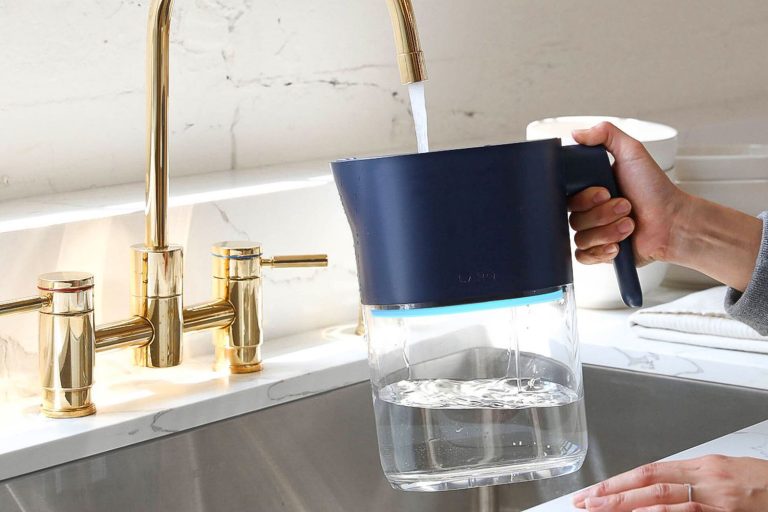Mold in your water pitcher can be a silent but pesky invader, compromising the purity of your drinking water and potentially affecting your health. You might have noticed a slimy film or an unpleasant odor that just won’t go away, despite regular cleaning.
If these issues sound familiar, you’re not alone. Keeping your water pitcher mold-free is crucial for ensuring your water stays fresh and safe to drink. Imagine the peace of mind you’ll have knowing every sip is clean and refreshing. You’ll discover simple, effective strategies to prevent mold from taking hold in your pitcher.
These tips are not only easy to follow but will also save you from the hassle of constant cleaning and potential health risks. Get ready to take control and enjoy pure, crisp water every day!

Credit: www.amazon.com
Choosing The Right Water Pitcher
Choosing the right water pitcher is crucial to keeping mold at bay and ensuring your drinking water is fresh and clean. It’s not just about aesthetics; the material and design features of your pitcher can make a significant difference. You might have experienced the frustration of scrubbing stubborn mold from your pitcher, only to have it return. Let’s dive into the key aspects you need to consider when selecting your ideal water pitcher.
Material Matters
The material of your water pitcher plays a significant role in mold prevention. Plastic pitchers are lightweight and affordable but can be prone to scratches that harbor mold. Consider choosing glass or stainless steel pitchers for durability and hygiene. Glass doesn’t retain odors or stains, and stainless steel is resistant to bacteria growth.
Think about how often you clean your pitcher. A material that’s easy to clean will save you time and effort. Glass pitchers can be quickly wiped down, while stainless steel can withstand a thorough scrub without damage.
Design Features To Consider
Design features can enhance your pitcher’s mold-resistance capabilities. Opt for pitchers with a wide mouth; they allow for easier cleaning and less chance for mold to hide. Consider models with removable lids and parts for thorough cleaning.
Look for pitchers with a built-in filter. Not only do they improve water taste, but they also prevent mold from forming by trapping impurities. A good filter system can make all the difference in maintaining your pitcher.
Have you ever struggled with a pitcher that didn’t fit in your refrigerator? Choose one with a compact design that fits well, ensuring your water stays cool and mold-free. This practical feature can save you from frustration and wasted space.
Ask yourself, what matters most to you in a water pitcher? Is it ease of cleaning, durability, or a space-saving design? By focusing on these features, you can keep your pitcher mold-free and enjoy fresh water every day.
Effective Cleaning Techniques
Keeping water pitchers mold-free requires regular cleaning. Rinse thoroughly and dry completely after each use. Use vinegar or baking soda to remove any mold traces, ensuring a fresh and clean pitcher.
Keeping your water pitchers mold-free requires consistent cleaning efforts. Mold not only affects the taste and smell of your water but can also pose health risks. An effective cleaning routine can help you maintain a pristine pitcher, ensuring your drinking water is always fresh and safe. Below, you’ll find practical cleaning techniques that you can easily implement at home.Using Natural Cleaners
Natural cleaners are a wonderful way to maintain your water pitcher without relying on harsh chemicals. Vinegar is a favorite—simply mix equal parts of vinegar and water. Let this solution sit in the pitcher for a couple of hours, then rinse thoroughly. Baking soda is another powerful natural cleaner. Sprinkle some into the pitcher, add water, and scrub gently with a soft brush. This combination can help eliminate any stubborn spots or odors. Lemon juice is effective too, and it leaves a fresh scent. Squeeze the juice of a lemon into the pitcher, fill it with warm water, and let it sit for 15 minutes. Rinse well to enjoy a mold-free pitcher.Deep Cleaning Methods
Sometimes, your pitcher might need a deeper cleaning effort. A mixture of hot water and dish soap can help. Fill the pitcher with hot, soapy water and let it soak for about 30 minutes. This process can help break down any mold buildup. For a more thorough clean, use a bottle brush to scrub the inside of the pitcher. Pay special attention to corners and grooves where mold can hide. Regular scrubbing can prevent mold from taking hold. If your pitcher has a filter, don’t forget it. Remove the filter and clean it separately, following the manufacturer’s instructions. A clean filter is crucial for keeping the entire system mold-free. Have you ever noticed how much better your water tastes from a clean pitcher? The effort you invest in cleaning it can make a significant difference. What cleaning technique will you try first?Regular Maintenance Practices
Clean water pitchers regularly to prevent mold growth. Wash with warm, soapy water and dry thoroughly. Store them in a cool, dry place.
Keeping your water pitcher mold-free doesn’t have to be a chore. By adopting regular maintenance practices, you can ensure your pitcher stays clean and your water tastes fresh. These practices are simple, quick, and can save you from the headache of dealing with mold. ###Daily Rinsing Routine
Start your day by rinsing the pitcher with warm water. This helps remove any residual particles that might have settled overnight. Make it a habit to also rinse the lid and spout, as mold can easily grow in these hidden spots. Consider setting a daily reminder on your phone. This small step ensures you never forget, even on busy mornings. Notice how clean your water tastes when you stick to this routine. ###Weekly Cleaning Schedule
Once a week, dedicate a few minutes to a more thorough cleaning. Use a mild dish soap and a soft brush to scrub the interior. Pay special attention to corners and crevices where mold loves to hide. Rinse thoroughly to remove all soap residue. If your pitcher is dishwasher-safe, consider giving it a cycle for a deeper clean. Have you noticed how a weekly clean extends the life of your pitcher? Engage with these practices consistently, and you’ll find that keeping your water pitcher mold-free is not only doable but also rewarding. What other maintenance practices have you found effective in your routine?Preventive Measures
To keep water pitchers mold-free, clean them regularly with warm soapy water. Dry thoroughly before refilling. Store in a cool, dry place to prevent mold growth.
Keeping your water pitcher mold-free ensures safe, clean drinking water. Mold can affect taste and health. Simple preventive measures can help. Regular cleaning and proper storage are key.Proper Storage Practices
Store your pitcher in a cool, dry place. Avoid areas with direct sunlight. Sunlight can promote mold growth. Ensure the lid is tightly closed. This prevents dust and debris from entering. Use a clean, dry cloth to wipe excess moisture. Moisture is a breeding ground for mold.Avoiding Contamination
Wash your hands before handling the pitcher. Dirty hands can introduce bacteria. Rinse fruits and vegetables before placing them in the pitcher. Leftover particles can lead to mold. Clean the pitcher regularly with warm, soapy water. This removes any hidden mold spores. Avoid using abrasive cleaners. They can scratch the surface. Scratches can harbor mold. Use a soft brush or sponge instead. “`Signs Of Mold Growth
Mold growth in water pitchers is a common issue. Recognizing the signs is crucial for maintaining a healthy environment. Mold can affect the taste and safety of your water. Identifying mold early can prevent health problems and maintain clean water.
Visual Indicators
Mold often appears as black or green spots. These spots may be slimy or fuzzy. Look for discoloration on the pitcher’s surface. Check the lid and spout areas. Mold may hide in corners or crevices. Inspect your pitcher regularly for these signs.
Health Implications
Drinking moldy water can cause health issues. Symptoms include coughing or sneezing. Mold exposure may lead to allergies. Some people experience throat irritation. Mold can worsen asthma conditions. Keeping pitchers mold-free protects your health.

Credit: www.facebook.com
Handling Moldy Pitchers
Keep water pitchers mold-free by cleaning them regularly with warm, soapy water. Ensure they dry completely before storing to prevent mold growth. Consider using a solution of vinegar and water for deeper cleaning.
Handling moldy pitchers can be frustrating, especially when you discover that the water you thought was clean and refreshing is now tainted. Mold can sneak into your pitcher without warning, but you can tackle this issue effectively with quick action and smart decisions. Imagine pouring a glass of water and noticing a strange smell or floating specks—it’s a wake-up call you can’t ignore. Addressing mold promptly can save your pitcher and keep your water safe. ###Immediate Action Steps
As soon as you notice mold in your pitcher, act fast. Begin by emptying the pitcher completely. This prevents any further contamination. Next, scrub the pitcher with hot water and dish soap. Use a brush that can reach corners and crevices. This ensures you remove all visible mold. Rinse thoroughly. Mold spores can linger, so make sure no soap residue remains. Rinsing helps eliminate the mold and prepares the pitcher for a deeper clean. ###When To Replace
Sometimes, cleaning isn’t enough. Consider replacing your pitcher if the mold persists despite thorough cleaning. Mold can become embedded in materials, making it impossible to remove completely. If your pitcher shows signs of wear, such as scratches or stains that won’t go away, it might be time for a new one. These imperfections can harbor mold, affecting the safety of your water. Ask yourself: how often do you see mold reappearing? Frequent mold issues could mean your pitcher is compromised. Investing in a new pitcher might be the best solution for ensuring your water stays clean and mold-free. Taking these steps ensures your water pitcher remains a reliable source of clean, refreshing water. Would you rather risk mold exposure, or enjoy peace of mind knowing your water is safe?Benefits Of Mold-free Water Pitchers
Keeping water pitchers mold-free is essential for health and taste. Mold can grow in damp environments and affect your drinking water. Ensuring your pitcher is mold-free offers a range of benefits. These benefits enhance your overall drinking experience and promote well-being.
Health Advantages
Drinking clean water supports a healthy lifestyle. Mold-free pitchers prevent mold-related health issues. Mold can cause allergies and respiratory problems. Keeping your pitcher clean helps avoid these risks. You enjoy safer and healthier hydration every day.
Enhanced Taste
Water from mold-free pitchers tastes better. Mold can leave a musty flavor in water. Removing mold keeps water fresh and crisp. You get to enjoy the pure taste of water. Clean pitchers preserve the natural flavor and quality.

Credit: www.amazon.com
Frequently Asked Questions
How To Keep Mold From Growing In Brita Pitcher?
Clean the Brita pitcher regularly using warm water and mild detergent. Dry thoroughly before refilling. Store in a cool, dry place, avoiding direct sunlight. Change filters as recommended to ensure water purity and prevent mold growth. Ensure the lid and spout are closed tightly to avoid contamination.
Do Water Filter Pitchers Get Mold?
Yes, water filter pitchers can develop mold. Regular cleaning prevents mold growth. Ensure proper maintenance by washing every few weeks. Always dry thoroughly after cleaning to avoid moisture buildup. Replace filters as recommended to maintain cleanliness and efficiency.
How To Keep Mold Out Of A Water Dispenser?
Clean the dispenser regularly using vinegar and water. Ensure proper ventilation and dry all parts thoroughly. Replace filters often to prevent mold growth. Avoid leaving stagnant water in the dispenser. Regular maintenance keeps mold away and ensures safe drinking water.
How To Remove Mold From A Water Pitcher?
Clean the pitcher with warm water and dish soap. Scrub mold using a brush. Rinse thoroughly. Mix vinegar and water, pour into the pitcher, let it sit for 15 minutes, and rinse again. Dry completely before use. Regular cleaning prevents mold growth and ensures safe drinking water.
Conclusion
Keeping your water pitcher mold-free is simple. Regular cleaning is key. Use warm water and mild soap. Scrub gently to remove residue. Dry completely before refilling. Store in a cool, dry place. Avoid direct sunlight. Replace filters as recommended. These habits ensure clean, safe water.
Protects your family’s health. Mold-free pitchers last longer. Less hassle in the long run. Regular maintenance saves time. And effort. Enjoy fresh, pure water every day. Healthy habits. Happy life.


